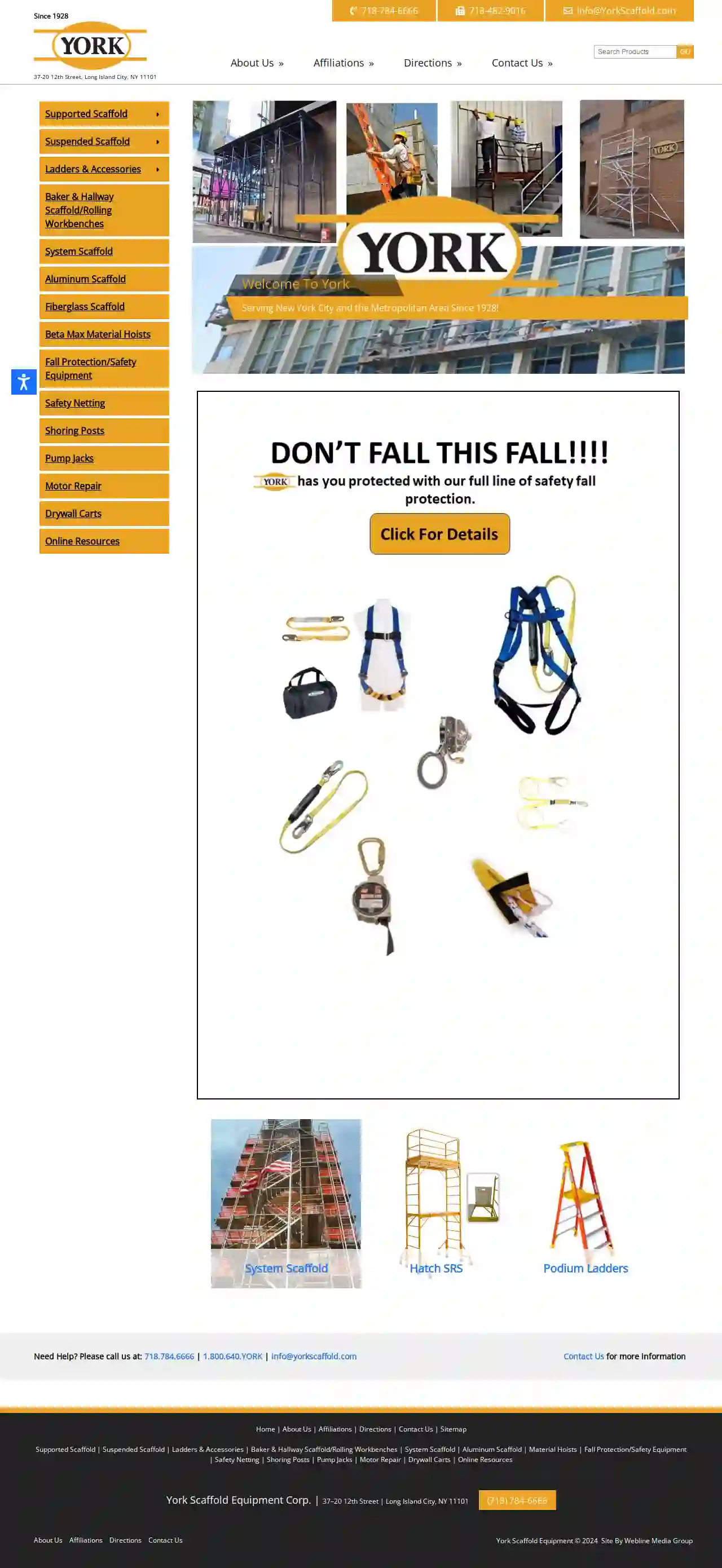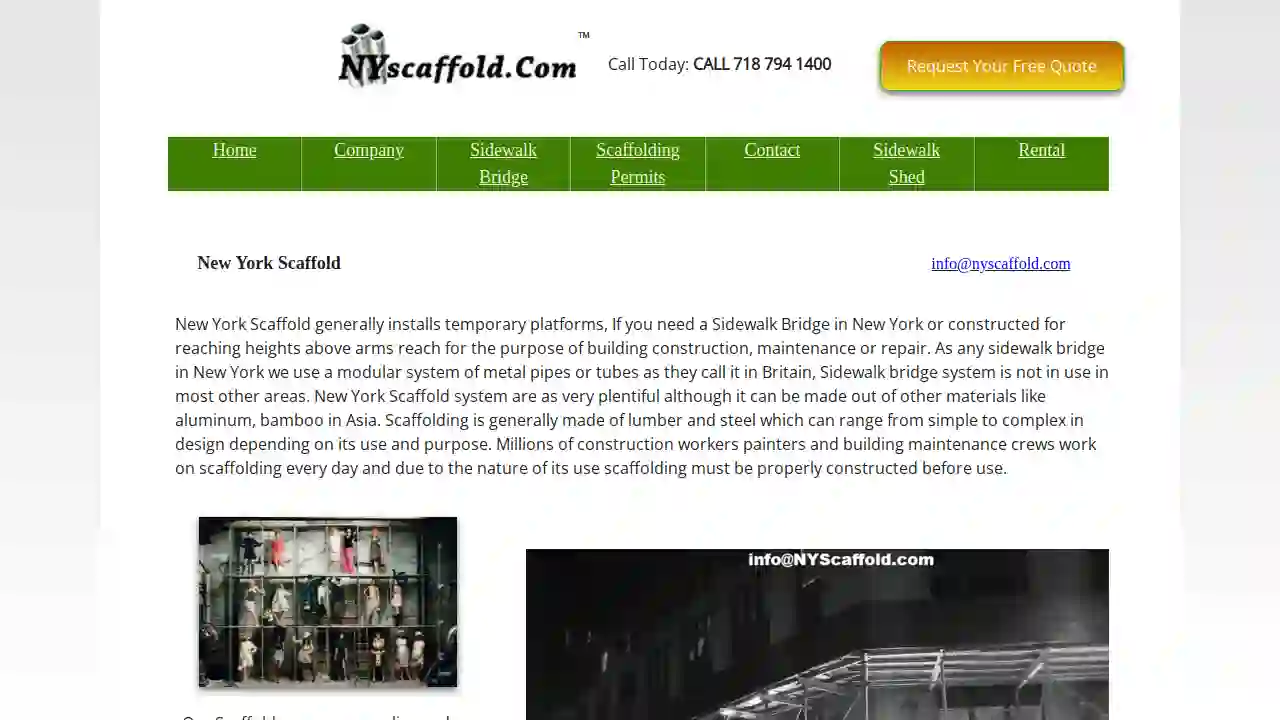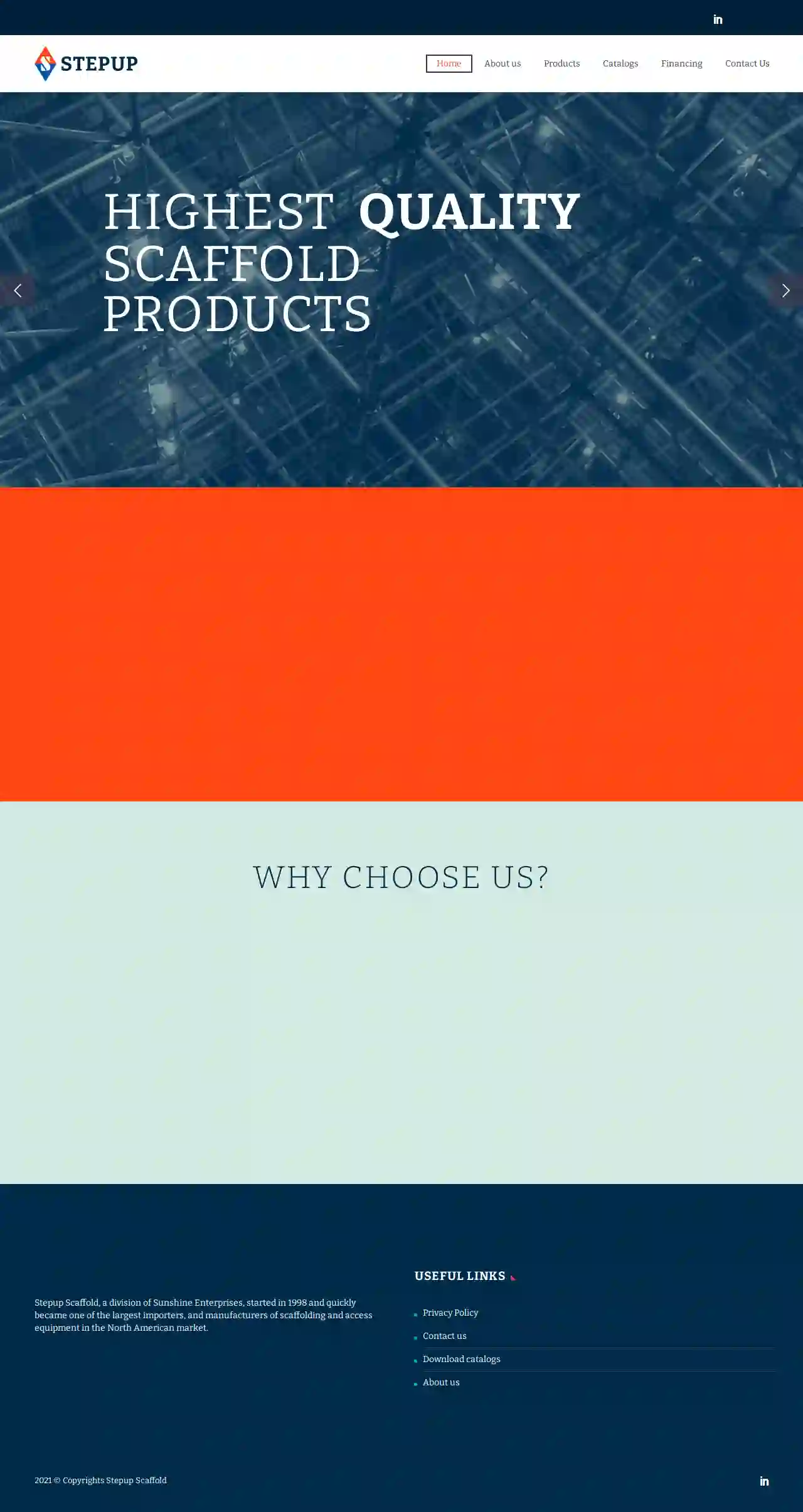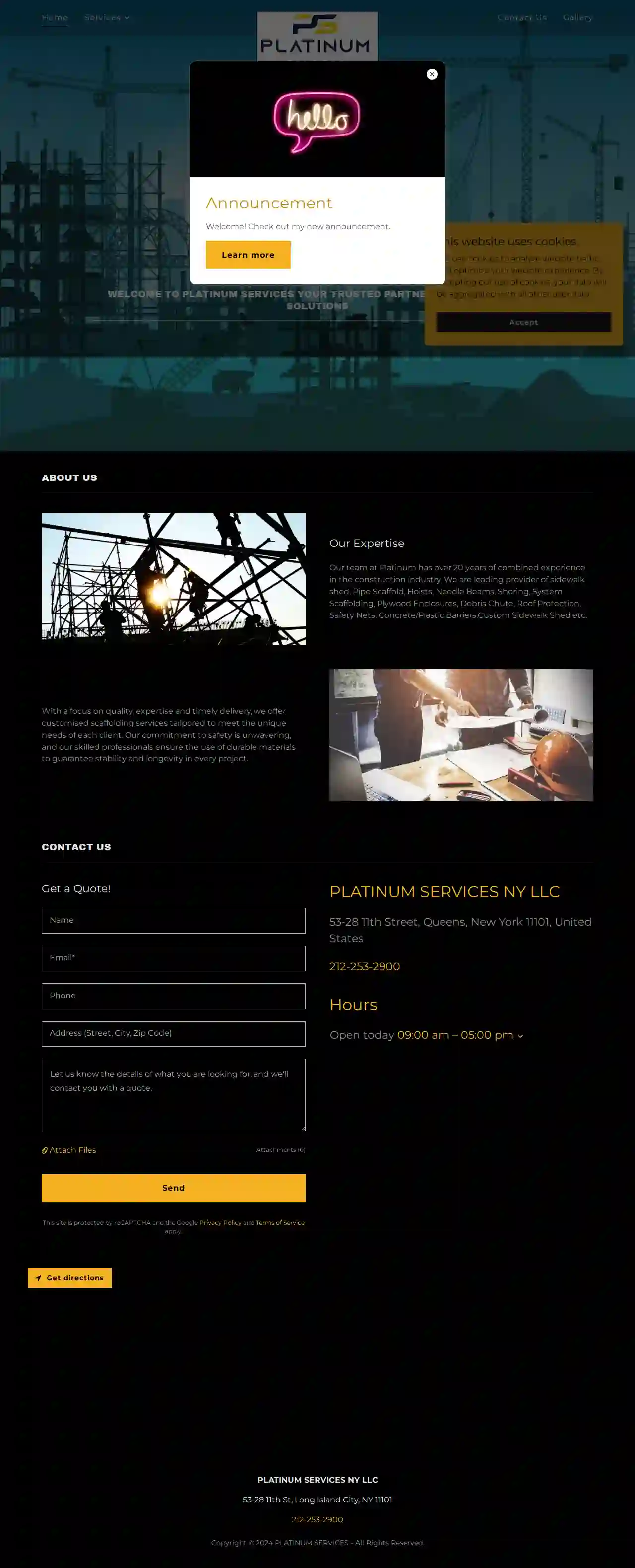Scaffolding Companies Ancient Oaks
Best Scaffolding Specialists in Ancient Oaks
Get multiple Scaffolding Solutions quotes for your project today! Compare profiles, reviews, accreditations, portfolio, etc... and choose the best service.

York Equipment Corp.
4.628 reviewsLong Island City, NY, 37-20 12th Street, 11101, USYork Scaffold Equipment Corp. has been serving New York City and the Metropolitan Area since 1928. The company specializes in providing a wide range of scaffolding solutions, including supported, suspended, and system scaffolds, as well as ladders, accessories, and safety equipment. With a strong commitment to customer satisfaction and safety, York Scaffold Equipment Corp. offers top-quality products and services to meet the needs of construction and renovation projects.
- Services
- Why Us?
- Accreditations
- Our Team
- Testimonials
- Gallery
Get Quote
Celtic Scaffolding Company
4.214 reviewsYork, USAt Celtic Scaffold, we specialize in providing top-notch scaffolding services to our clients in New York City. With years of experience in the industry, our team of experts is well-versed in the different types of scaffolds, including pipe scaffolds and hanging or suspension scaffolds. Our pipe scaffolds are stationary and constructed with pipes, erected from the ground up along the side of a building. We ensure that our pipe scaffolds comply with the regulations set by the Construction Division within each borough office of the Department of Buildings (DOB). On the other hand, our hanging or suspension scaffolds are supported from the roof or setback of a building and held by either cables or rope. We contract master riggers or special riggers for the work, and each worker using or operating the suspension scaffold must be employed by the master rigger, special rigger, or their company.
- Services
- Why Us?
- Gallery
Get Quote
Kings Group NY Corp
51 reviews120-5 Atlantic Ave, Suite #2, Richmond Hill, 11418, USAt Kings Group NY, we prioritize Safety and Quality in every project we undertake. Our mission is to ensure that our clients receive the best possible service, from the initial consultation to the completion of the project. With a team of experienced professionals, we provide top-notch scaffolding services to contractors, construction managers, developers, and building owners. Our organization is committed to meeting project budgets, schedules, and daily safety codes, and we take pride in our ability to deliver exceptional results. Our team is comprised of NYC DOB and OSHA code-certified professionals who are dedicated to providing the highest level of service. We offer a range of services, including sidewalk sheds, scaffolding, hoists, and other specialized services. Our goal is to provide our clients with the best possible experience, and we strive to exceed their expectations in every way.
- Services
- Why Us?
- Accreditations
- Gallery
Get Quote
NY Scaffold
51 reviewsYork, USWe are national scaffold contractors and scaffolding erectors. Experienced NY Scaffold erectors can provide a range of access services for you or your clients, we also take care of any and all NYC DOB Permits. Large and small projects; industrial, commercial and domestic sectors can hire the services of NY Scaffold erectors. No job is too big or too small for us and we have grown our business in the last few years to become one of the leading erectors of scaffolding and sidewalk bridges in the NYC area. Plan your project with complete confidence the sidewalk bridge company NYC can erect scaffolding to all types of structures. NYC installs scaffolds from access towers to bridges and any other type of access equipment that your firm might require. It does not matter how big or how small your project is NY scaffold company NYC will cater to your needs. They have secure access equipment that is perfect for projects in and around the region. Our Scaffolding has several unique safety features that benefit the system’s erectors, users and project inspectors. With eight completely variable component node points and the largest available bay sizes, Our Scaffolding offers the most flexible system. Only five main components are required for basic use and the only erection tools required are a hammer and level. The system’s optimum design offers a high load rating and extreme rigidity, keeping your workers secure and productive. NY Scaffold is the leading specialty Scaffold Erector Company covering the whole of the US. We are totally focused on customer satisfaction and pride ourselves on the range of services we provide, We have 95% repeat business on an ongoing basis. NY Scaffold is fully self-sufficient and one the largest stockholders of the sidewalk bridge system within the US. This forms the basis of the NY Scaffolds motto safety speed efficiency. Our business is based around the materials that are stored in bins and are loaded by forklift in our yards and unloaded on site by our Truck mounted Booms. We deliver our scaffolding equipment to your site, and our team of experienced erectors will set it up for you, ensuring that your project is completed safely and efficiently.
- Services
- Why Us?
- Gallery
Get Quote
Dynamic Hoisting & Scaffolding
54 reviews43-30 48th St, Long Island City, 11104, USAt Dynamic Hoisting & Scaffolding, we transform your vision into reality with our expertise in hoisting and scaffolding solutions. Our team is dedicated to delivering exceptional results, ensuring your projects are completed on time and within budget. Established in 2013, Dynamic Hoisting & Scaffolding is dedicated to providing high-quality construction services that exceed our clients' expectations. Our mission is to innovate, sustain, and continually improve every aspect of our work. Join us in transforming the construction landscape with our reliable scaffolding solutions. We use the highest quality materials and craftsmanship to ensure durability and excellence in every project. We conduct our business with transparency, honesty, and respect, prioritize the safety of our employees, clients, and the community, and embrace new technologies and methods to enhance efficiency and effectiveness.
- Services
- Why Us?
- Testimonials
- Gallery
Get Quote
StepUp Scaffolding Warehouse - NY Branch
4.426 reviews1234 NW 12th St, Miami, 33122, USStepup Scaffold, a division of Sunshine Enterprises, started in 1998 and quickly became one of the largest importers and manufacturers of scaffolding and access equipment in the North American market. Our commitment to Quality, Service, and Satisfaction influences everything we do. We believe that a high tide raises all boats, so to raise everything and everyone, our statement of purpose, simply put is that “We elevate our employees, customers, and industries to safely move, build, and maintain the world.”
- Services
- Why Us?
- Accreditations
- Our Team
- Testimonials
- Gallery
Get Quote
West New York Restoration of CT, INC
4.512 reviews1800 Boston Rd, Bronx, 10460, USWest New York Restoration of CT, Inc was founded in 1984 by Principal Alfred Gallicchio with the goal of providing high-quality contracting services in the field of exterior restoration, roofing and waterproofing. The philosophy of the company and its owner is a simple and direct one: to combine experience, management services, and skilled workforce to achieve the highest level of quality for each project. West New York Restoration of CT, Inc.'s key personnel bring a wealth of experience to each project. Whether the problem at hand concerns roofing, waterproofing, masonry, or structural repair, West New York Restoration of CT, Inc. can provide the solution.
- Services
- Why Us?
- Our Team
- Gallery
Get Quote
ANDAMIO SCAFFOLDING LLC
20 Burling Lane, Suite 4-1, New Rochelle, 10801, USAt ANDAMIO SCAFFOLDING LLC, we pride ourselves on our commitment to safety, customer satisfaction, and exceptional service. With a strong focus on our values and safety 1st culture, we strive to provide top-notch scaffolding solutions to our clients. Our team is dedicated to assisting you with all your scaffolding needs, from permits and insurance renewals to project onboarding and billing. Reach out to us today to learn more about our services and how we can help you achieve your goals.
- Services
- Why Us?
- Accreditations
- Gallery
Get Quote
ZKW Enterprises Inc.
3.25 reviewsBronx NY, Suite 210, 749 East 135th street, Bronx, 10454, USZKW Enterprises, based in the Bronx, offers top-quality scaffolding rental, sale, installation, and service. With over 15 years of experience, we ensure safe and efficient project completion with reliable equipment at affordable rates. The company was founded in 2018 by Zunair khalid and Amarah Bhutta. We specialize in all sorts of scaffolding including suspended scaffolding, pipe scaffolding, and roof protection. We also specialize in construction work like masonry, exterior work including brick, stucco, lintel, facade work, and local law. Our team is committed to helping every customer complete their projects quickly and safely.
- Services
- Why Us?
- Accreditations
- Our Team
- Testimonials
- Gallery
Get Quote
Platinum Services
34 reviews53-28 11th St, Long Island City, 11101, USWelcome to Platinum Services, your trusted partner in scaffolding solutions. With over 20 years of combined experience in the construction industry, our team at Platinum has the expertise to provide customized scaffolding services tailored to meet the unique needs of each client. Our commitment to safety is unwavering, and our skilled professionals ensure the use of durable materials to guarantee stability and longevity in every project. We offer a range of services, including sidewalk shed, Pipe Scaffold, Hoists, Needle Beams, Shoring, System Scaffolding, Plywood Enclosures, Debris Chute, Roof Protection, Safety Nets, Concrete/Plastic Barriers, and Custom Sidewalk Shed. Contact us today to get a quote and learn more about our services.
- Services
- Why Us?
- Gallery
Get Quote
Over 2,353+ Scaffolding Contractors on our directory
Our scaffolding experts operate in Ancient Oaks & surrounding areas!
ScaffoldingHQ has curated and vetted Top Scaffolding Companies near Ancient Oaks. Find a top & trustworthy pro today.
Frequently Asked Questions About Scaffolding Companies
- A larger, more complex structure typically used for accessing multiple levels of a building.
- Offers greater height and versatility.
- Often used for construction, renovation, and maintenance.
- Smaller, portable platforms usually used for tasks at a single level.
- Commonly used for painting, plastering, or light repairs.
- Can be rolling or stationary.
- Stability and Level: The scaffolding is level and firmly supported by a solid foundation.
- Secure Connections: All components (tubes, clamps, fittings) are properly connected and tightened.
- Guardrails and Toeboards: Adequate guardrails and toeboards are in place to prevent falls.
- Platforms and Decking: Platforms are secure, free from damage, and provide adequate working space.
- Access and Egress: Safe access and exit points are available (ladders, stairs).
- Weather Protection: Appropriate measures are in place to protect workers from adverse weather conditions (e.g., wind screens, covers).
- Clearance from Hazards: The scaffolding is a safe distance from power lines, trees, or other potential hazards.
- Scaffolding Tag: The scaffolding tag is up-to-date and displays the last inspection date, maximum load capacity, and any restrictions.
- Hire Professionals: Just like erection, dismantling should be done by qualified and experienced scaffolding erectors.
- Reverse the Erection Process: The dismantling process should generally follow the reverse order of erection.
- Clear the Area: Ensure the area below is free from people and obstacles.
- Lower Materials Safely: Use ropes or other safe methods to lower dismantled components to the ground.
- Inspect Components: As components are removed, inspect them for damage and store them properly for future use.
- Size and Complexity: Larger, more intricate scaffolding structures will naturally take longer to assemble.
- Scaffolding Type: System scaffolding, with its pre-engineered components, can be erected faster than traditional tube and clamp scaffolding.
- Accessibility: Difficult site access or limited working space can prolong the erection process.
- Crew Size and Experience: The number and skill level of the scaffolding erectors will impact the speed of assembly.
What is the difference between scaffolding and staging?
Scaffolding:
What should I look for during a scaffolding inspection?
How do I dismantle scaffolding safely?
How long does it take to erect scaffolding?
What is the difference between scaffolding and staging?
Scaffolding:
- A larger, more complex structure typically used for accessing multiple levels of a building.
- Offers greater height and versatility.
- Often used for construction, renovation, and maintenance.
- Smaller, portable platforms usually used for tasks at a single level.
- Commonly used for painting, plastering, or light repairs.
- Can be rolling or stationary.
What should I look for during a scaffolding inspection?
- Stability and Level: The scaffolding is level and firmly supported by a solid foundation.
- Secure Connections: All components (tubes, clamps, fittings) are properly connected and tightened.
- Guardrails and Toeboards: Adequate guardrails and toeboards are in place to prevent falls.
- Platforms and Decking: Platforms are secure, free from damage, and provide adequate working space.
- Access and Egress: Safe access and exit points are available (ladders, stairs).
- Weather Protection: Appropriate measures are in place to protect workers from adverse weather conditions (e.g., wind screens, covers).
- Clearance from Hazards: The scaffolding is a safe distance from power lines, trees, or other potential hazards.
- Scaffolding Tag: The scaffolding tag is up-to-date and displays the last inspection date, maximum load capacity, and any restrictions.
How do I dismantle scaffolding safely?
- Hire Professionals: Just like erection, dismantling should be done by qualified and experienced scaffolding erectors.
- Reverse the Erection Process: The dismantling process should generally follow the reverse order of erection.
- Clear the Area: Ensure the area below is free from people and obstacles.
- Lower Materials Safely: Use ropes or other safe methods to lower dismantled components to the ground.
- Inspect Components: As components are removed, inspect them for damage and store them properly for future use.
How long does it take to erect scaffolding?
- Size and Complexity: Larger, more intricate scaffolding structures will naturally take longer to assemble.
- Scaffolding Type: System scaffolding, with its pre-engineered components, can be erected faster than traditional tube and clamp scaffolding.
- Accessibility: Difficult site access or limited working space can prolong the erection process.
- Crew Size and Experience: The number and skill level of the scaffolding erectors will impact the speed of assembly.